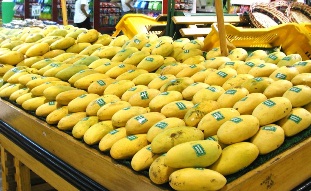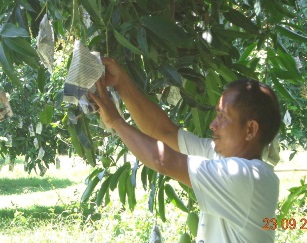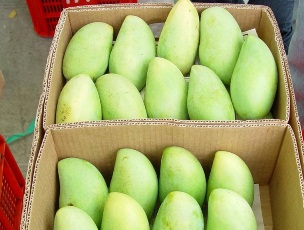The Philippines ranks 12th among the top producers of mango in the world, with 2% share in production (FAO, 2012). It is also the third most important fruit crop based on export volume in the Philippines, next to banana and pineapple. It has very high potential as fresh or processed export product to other untapped export destinations. However, mango production in the Philippines is still constrained by a number of problems that limit its full potential. These include occurrence of pests and diseases, poor soil nutrition, low adoption of improved technologies, and high post-harvest losses, that cause substantial reduction in fruit yield and quality.

Ripe mangoes on display for sale at Robinsons Supermarket, Los Baños, Laguna (Photo by Victor V. Oro)
The Industry Strategic S&T Program (ISP) for mango aims to address identified problems in the mango technology chain by providing science solutions in the form of science and technology (S&T) interventions with corresponding resources to achieve desired targets. The ISP for mango aims to increase yield by 90% (from 5.82 mt/ha to 11.11 mt/ha), reduce postharvest losses by 50% (from 40% to 20%), and enhance the capability of mango growers on Integrated Crop Management (ICM), Postharvest Quality Management (PQM), and Good Agricultural Practices (GAP).

A mango farmer bagging the fruits to protect them from pests and diseases and ensure high recovery of marketable fruits in General Santos City, South Cotabato (Photo by Allan B. Siano)
Two major programs on mango were crafted to come up with holistic approach in addressing identified gaps. Some of the outputs of the National Science and Technology Program for ‘Carabao’ Mango (NSTPCM) include the putative mango hybrids with target traits such as red blush and thick skin, and resistance to pests and diseases; optimized management strategies against mango pests; developed geodatabase, suitability and vulnerability maps; and produced diagnostic kit for identification of true-to-type ‘Carabao’ mango variety.
Under the Advancing the Philippine Mango Industry: Production of Export Quality Mangoes Program or APMI:PEQM, pre- and postharvest equipment such as mechanical fruit picker, low-volume power sprayer, and model integrated postharvest facility have been developed. Mango growers, contractors, and LGUs were trained on ICM, PQM and GAP for mango.

Mangoes delivered from Davao were packed in the Food Terminal Incorporated (FTI) and readied for export. (Photo by Victor V. Oro)
The ISP for Mango, among other ISPs, as a program, has been conceived by the government through the Philippine Council for Agriculture, Aquatic and Natural Resources Research and Development of the Department of Science and Technology (DOST-PCAARRD) in 2012. The Program seeks to provide the vision and direction for all actors and key players in the agriculture, aquatic, and natural resources sectors in the Philippines.
DOST-PCAARRD will showcase the ISP for mango including other science and technology (S&T) agri-aqua research and development (R&D) outputs on March 2-4, 2016 during the SIPAG FIESTA at its headquarters in Los Baños, Laguna.
SIPAG, a technology transfer strategy, embodies the Council’s commitment to DOST’s Outcome One in a bid to ensure that the fruits of R&D activities for the agri-aqua sectors will be a blessing for every Juan.
by Allan B. Siano, DOST-PCAARRD S&T Media Service
